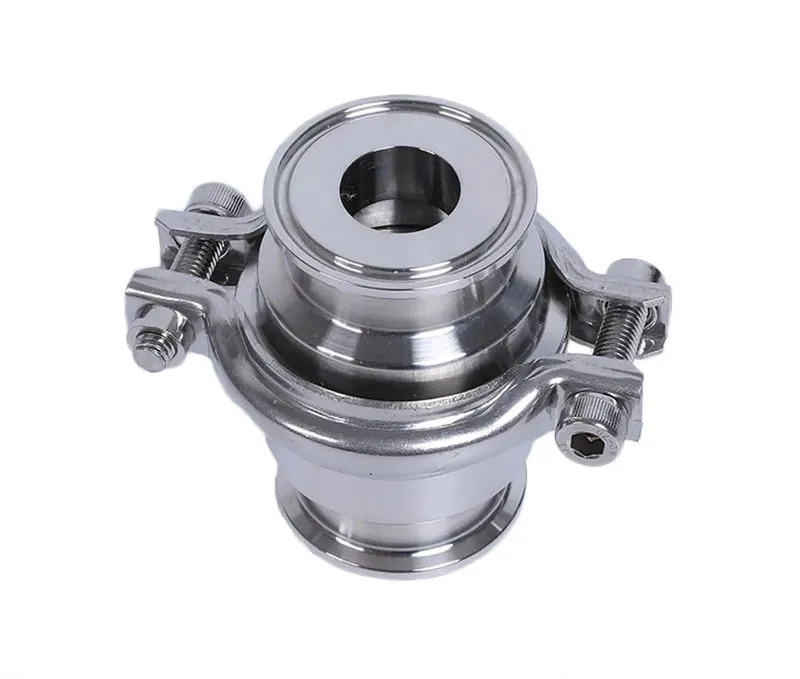Sanitary valves are crucial in hygiene-sensitive industries like food, pharmaceuticals, and biotechnology. A wrong choice can compromise product quality and lead to regulatory issues. Here are key factors for selecting suitable sanitary valves.
1. Meet Regulatory Standards
Compliance with international or regional standards is essential:
- FDA (USA): Demands non-toxic materials for food/drug contact; 316L stainless steel is commonly approved.
- 3A Sanitary Standards (North America): Specifies surface roughness (Ra ≤ 0.8μm internally) for dairy and food equipment.
- EHEDG (Europe): Focuses on hygienic design, requiring crevice-free construction.
- ISO 20378 (Pharmaceuticals): Sets rules for pharmaceutical valves, emphasizing traceability.
Action: Choose valves with relevant certifications. For global use, prioritize multi-standard compliance.

Sanitary Tri Clamp Check valve
2. Select Appropriate Materials
Material impacts corrosion resistance and cleanability:
- Stainless Steel: 304 for non-corrosive media; 316/316L for acids, alkalis, and better weldability.
- Alloy 22 (Hastelloy): For extreme corrosion (e.g., concentrated acids).
- Seal Materials: EPDM for water-based systems; FEP/PFA for aggressive fluids; silicone for high temperatures, but avoid in particle-sensitive processes.
Avoid valves with cast parts or non-hygienic coatings. Always check material certifications.
3. Opt for Hygienic and Functional Designs
A good design reduces residue and cleaning difficulties:
- Surface Finish: Internally, Ra ≤ 0.8μm for food, Ra ≤ 0.5μm for pharma; externally, Ra ≤ 1.6μm.
- Crevice-Free: Avoid dead legs (length/diameter > 3:1) and choose welded or electropolished valves.
- Connections: Tri-Clamp for easy cleaning; weld ends for high-purity systems; avoid threaded connections except for low-risk uses.
- Valve Types: Ball valves for on/off; diaphragm valves for aggressive fluids; butterfly valves for high flow.
4. Match Operational Needs
Align the valve with process conditions:
- Pressure/Temperature: Low-pressure (≤ 10 bar) for food; high-pressure (≥ 50 bar) for specialized tasks; temperature ranges from cryogenic to over 300°C.
- Flow/Viscosity: Large-bore valves for high-viscosity fluids; smooth valves for shear-sensitive products.
- Actuation: Manual for infrequent use; pneumatic for automation; electric for precise control; hydraulic for high pressure (less common in sanitary settings).
5. Ensure Cleanability and Sterilization
- CIP: Valves should allow unobstructed cleaning.
- SIP: Materials must withstand steam (e.g., 121°C for 30 min); avoid plastics in SIP areas.
- Autoclaving: Portable valves should be disassemblable for autoclaving.
6. Evaluate Supplier Quality
- Manufacturing: Choose suppliers with in-house machining, electropolishing, and ISO 9001 certification.
- Testing: Request pressure, leak, and material compatibility reports.
- Service: Ensure access to spare parts and technical support.
7. Consider Total Cost
Balance initial cost with long-term durability. Cheaper valves may cost more due to frequent replacement or compliance risks.
8. Test Before Adoption
Test valves in actual process conditions, evaluate cleanability after CIP/SIP, and conduct microbial tests for pharma applications.
Conclusion
Choosing a sanitary valve requires balancing regulations, materials, design, and operations. Prioritize quality and partner with experienced suppliers to avoid costly errors.
